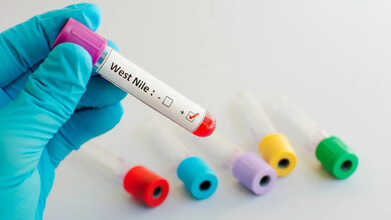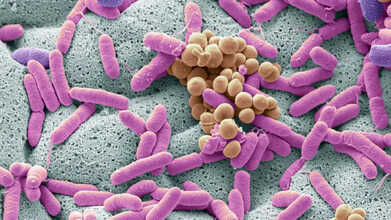- Health Conditions A-Z
- Health & Wellness
- Nutrition
- Fitness
- Health News
- Ayurveda
- Videos
- Medicine A-Z
- Parenting
- Web Stories
Canadian Swimmer, Penny Oleksiak Handed Provisional Suspension Over Anti-Doping Violation, 'I Am Clean,' She Says

Credits: Olympics.com, Canadian Olympic Committee, Wikimedia Commons
Swimmer Penny Oleksiak Anti-Doping Allegations: In the chain of news where many sports persons have been pulled up due to their anti-doping results, including Jannik Sinner, Tara Moore, and Ruth Chepngetich, Canadian swimmer Penny Oleksiak has also made news. Though her case differs, as she has been notified of an apparent anti-doping rule violation by the International Testing Agency (ITA).
As per ITA, Oleksiak committed three whereabout failures within a 12-month period between October 2024 and June 2025. Oleksiak of Toronto, who is a three-time Olympian, has accepted a voluntary provisional suspension pending the resolution of the matter.
The ITA gives her the right to explain why she had missed three whereabouts. In a now-deleted Instagram post, Oleksiak announced that she was withdrawing from the world championship and accepting a voluntary provisional suspension. Her post read: "I am and always have been a clean athlete". The post also noted that the case "does not involve any banned substance; it's about whether I updated my information correctly."
Swimming Canada also agreed and wrote: "We support her decision and believe she is a clean athlete who made an administrative mistake."
What Is A Whereabouts Case?
As per the World Anti-Doping Agency (WADA), whereabouts is information provided by athletes so Anti-Doping Organizations (ADO) can locate them for testing, particularly for out-of-competition testing.
Athletes who need to provide whereabouts information are usually part of a Registered Testing Pool (RTP).
A Whereabouts case is considered an anti-doping rule violation and can impact an athlete's eligibility, even if they haven’t used any banned substances. According to the World Anti-Doping Code, it involves any combination of three missed tests or filing failures within a 12-month period. According to World Aquatics, if an athlete in the testing pool submits "late, inaccurate or incomplete whereabouts that lead to [them] being unavailable for testing, [they] may receive a Filing Failure."
What Information Is Required For A Whereabout Case?
As per WADA, the RTP athletes are required to provide the following information to ADO:
- Home address, email address and phone number
- An overnight accommodation address
- Regular activities, such as training, work, school or University and their locations plus times they will be there
- Competition schedules including when they are taking place and where
- A 60-minute time slot for each day where they’ll be available and accessible for testing
What Are The Common Drugs Used By Swimmers?
As per the Anti-Doping Database, top three banned substances for swimmers are cannabis, methylhexaneamine, and nandrolone.
Surprisingly, cannabis is the top contender of all. It is most commonly detected substance among banned swimmers and is not an Anabolic Steroid, which are a class of drugs that are structurally linked to testosterone, which helps in muscle building. Cannabis is a cannabidiol. As per the data, swimmers from France comprise the largest group testing positive for this substance, followed by Italy, Spain, and Belgium.
"While investigations of whole cannabis and THC have generally shown either null or detrimental effects on exercise performance in strength and aerobic-type activities, studies of sufficient rigor and validity to conclusively declare ergogenic or ergolytic potential in athletes are lacking," notes a 2021 Study, published in Springer's Sports Medicine.
The second most common banned substance is Methylhexaneamine. It has resulted in bans for swimmers from Russia, India, and Poland. As per the National Library of Medicine, National Center for Biotechnology Information, USA, it is an amphetamine derivative that has been widely used in sports supplements sold in the United States. It was placed under the WADA prohibition list in 2010 and is classified as a Non Specified Stimulant prohibited in-competition only. It is also a performance-enhancing substance.
Nandrolone, an Anabolic Steroid, notes the Anti-Doping Database, secures the third spot among top banned substances in summing. Athletes from Brazil, India, and Greece have tested positive for Nandrolone, a substance long associated with sports doping.
A 2020 study published in journal Medicina, notes, that skeletal muscle "can be" considered as the primary target tissue for nandrolone's effects. It can also increase muscle size and could be administered via injections, and is "metabolized in a similar manner to testosterone".
Johnny Ball Reveals Prostate Cancer Diagnosis; Early Symptoms You Should Know

Credits: Rii Schroer
Children’s TV presenter Johnny Ball spoke openly on Monday’s Good Morning Britain about his prostate cancer diagnosis from 2022. During the ITV show, hosts Ed Balls and Susanna Reid discussed Ball’s health and recovery. The 87-year-old, father of radio host Zoe Ball and well-known for shows like Play School, revealed that he successfully completed treatment and is now in good health.
Reflecting on his experience, Ball said, “I was diagnosed with prostate cancer in August 2022. Thankfully, after three months of daily radiation therapy starting in September, I’m through it and feeling well.” He acknowledged that the disease can be fatal, citing friends who lost their lives to it, including Goon Show star Harry Secombe and comedian Bob Monkhouse. “I’m 20 years younger than them, and I feel fortunate because today we can treat it successfully,” he added.
Ball also stressed the importance of regular check-ups. Despite showing no symptoms, his cancer was discovered during a routine GP visit. His PSA levels were at 30, far above the normal threshold of three, highlighting the value of screening even in the absence of symptoms.
What Is Prostate Cancer?Prostate cancer develops in the prostate, a small gland in the male reproductive system responsible for producing fluid that forms part of semen. The condition occurs when cells in the prostate grow uncontrollably, potentially forming a tumor. While some forms grow slowly and may not immediately threaten health, the cancer can be dangerous if it spreads beyond the prostate. Factors that increase risk include age, genetics, and ethnicity.
What is the Prostate?
The prostate is a small gland located just below the bladder in men. Its primary role is to produce seminal fluid, which helps nourish and transport sperm.
How Does Prostate Cancer Develop?
Cancer in the prostate begins when certain cells start growing abnormally. These cells multiply faster than normal, eventually forming a tumor.
Early Warning Signs Of Prostate Cancer
Prostate cancer often does not cause noticeable symptoms in its early stages. When symptoms do appear, they usually involve changes in urination:
- Frequent urination, especially at night
- Difficulty starting or stopping urine flow
- Weak or interrupted stream
- Urgency, or a sudden, hard-to-control need to urinate
- Feeling of incomplete emptying after urination
Other possible signs include:
- Blood in urine or semen
- Erectile dysfunction
- Pain or burning during urination or ejaculation
- Persistent pain in the lower back, hips, pelvis, or upper thighs
- Weakness or numbness in later stages
Because early prostate cancer often produces few or no obvious symptoms, regular check-ups and screenings are crucial, particularly for men with risk factors. Anyone noticing these signs should seek medical advice promptly.
West Nile Virus Risk Raised To ‘High’ As Two New Cases Emerge In The US

Credits: Canva
Massachusetts health officials have reported two new human cases of West Nile virus, raising the state’s total this season to eight. In its update on Friday, September 6, 2025, the Department of Public Health (MDPH) said the latest cases involve a woman in her 60s from Middlesex County and a man in his 50s from Suffolk County.
Because of these new infections, the risk level for West Nile has been raised to “high” in four communities, Arlington, Chelsea, Medford, and Waltham. Overall, 47 municipalities and more than 200 cities and towns across Massachusetts are now considered high-risk.
Public Health Commissioner Robbie Goldstein noted that the state is “almost out of the peak season” for West Nile transmission, but added that the threat will remain until the first hard frost arrives. He advised residents to continue protecting themselves by using mosquito repellent and wearing long sleeves and pants to reduce exposed skin.
What Is the West Nile Virus?
West Nile virus is a mosquito-borne illness that was first identified in Uganda’s West Nile district. Most people who are infected never develop symptoms, but about one in five will experience mild flu-like issues such as fever, headaches, muscle aches, and fatigue, sometimes referred to as West Nile fever.ALSO READ: West Nile Virus Isn't Over Yet, New Cases In US On Rise
In rare but serious cases, the virus can affect the nervous system, leading to brain or spinal cord inflammation (encephalitis or meningitis). These severe infections may cause symptoms such as confusion, seizures, paralysis, or even coma.
How Common Is West Nile Virus?
West Nile virus is found on nearly every continent, including North America, Europe, Africa, Asia, and Australia. In the United States, it is the most common disease spread by mosquitoes, with cases documented in 49 states. Since it first appeared in the U.S. in 1999, more than 51,000 symptomatic cases have been reported.This year alone, the Centers for Disease Control and Prevention (CDC) has confirmed 1,137 cases of West Nile across 42 states as of September 23, 2025. Of those, 742 were classified as “neuroinvasive,” meaning the infection spread to the nervous system.
West Nile Virus Symptoms and Causes
Typical symptoms of West Nile fever may include:- Fever
- Headache
- Muscle aches
- Nausea or vomiting
- Diarrhea
- Rash on the chest or back
- Swollen lymph nodes
- Sore throat
- Pain behind the eyes
Severe symptoms of West Nile encephalitis or meningitis can include:
- Sudden, intense headache
- High fever (above 103°F or 39.5°C)
- Stiff neck
- Confusion or disorientation
- Muscle weakness
- Tremors or convulsions
- Seizures
- Paralysis
- Coma
West Nile Virus: Public Awareness and Concerns
Despite the rising case count, concern among Americans remains relatively low. A recent survey conducted by the Annenberg Public Policy Center (APPC) of the University of Pennsylvania found that only 15 percent of U.S. adults worry about themselves or a family member contracting West Nile or dengue fever in the next three months. This level of concern is unchanged from September 2024.“With the growing number of West Nile cases and an extended mosquito season, people need to be more aware of the risks,” said Ken Winneg, managing director of survey research at APPC. He advised communities to take everyday precautions, including reducing standing water where mosquitoes breed and protecting against bites.
Walmart Recalls Pasta and Meatballs Over Listeria Contamination; What You Should Know

Credits: Canva
Walmart pasta meals listeria recall: The U.S. Department of Agriculture (USDA) has issued a public health alert for a ready-to-eat pasta meal sold at Walmart due to possible listeria contamination, a potentially deadly bacteria. The alert, announced Thursday, affects customers nationwide. Officials are urging consumers to immediately check their freezers for the affected product.
Details of the Walmart Pasta Recall
The recall involves Marketside Linguine with Beef Meatballs and Marinara Sauce, sold in 2-ounce clear plastic trays. Specific “best if used by” dates affected are September 22, 24, 25, 29, 30, and October 1, 2025. The products were distributed to Walmart stores across the country. Consumers are advised not to eat the pasta and should either discard it or return it for a full refund, as per CT Insider.Also Read: World Heart Day 2025: Theme, History, and Significance - Why It's Celebrated on September 29?
This alert is linked to a previous listeria outbreak involving recalled chicken fettuccine Alfredo meals in June. According to Fox Business, testing was expanded to include other products, and one sample of the Marketside linguine meal tested positive for listeria. The USDA issued the alert to prevent further illness, as the contamination could potentially be more widespread.
Walmart Recall Listeria: What Is Listeria?
Listeria is a type of bacteria that causes listeriosis, a serious foodborne illness. It can be found in soil, water, and contaminated foods, especially ready-to-eat meals, deli meats, soft cheeses, and prepackaged items like Walmart’s recalled pasta. Unlike many bacteria, Listeria can survive and even grow in refrigerated conditions, which makes proper food handling and cooking critical, as per Centers for Disease Control and Prevention.Listeria: Who Is Most At Risk?
While anyone can contract listeriosis, certain groups are more vulnerable. Pregnant women, newborns, older adults, and people with weakened immune systems face the highest risk of severe illness. For pregnant women, infection can cause miscarriage, stillbirth, or serious infection in newborns.
Listeria Symptoms To Watch For
Symptoms of listeriosis usually appear within a few days to weeks of consuming contaminated food. Common signs include fever, muscle aches, nausea, and diarrhea. Severe infections can lead to headaches, stiff neck, confusion, loss of balance, or convulsions if the bacteria spread to the nervous system. Early medical attention is crucial, especially for high-risk individuals.Also Read: Katie Thurston Opens Up About Stage 4 Breast Cancer Journey
Walmart Recall Listeria: How to Stay Safe
Consumers should check their freezers and pantries for affected products, like the Marketside linguine with beef meatballs, and discard or return them. Proper cooking and avoiding unpasteurized dairy or prepackaged ready-to-eat meals can reduce risk. Always follow food safety guidelines, including cleaning, separating, cooking, and chilling foods.
Walmart Recall Listeria: Recent Trends in Food Recalls
Food recalls over listeria have become increasingly common in recent years. Just this summer, Kraft Heinz pulled back more than 367,000 pounds of Oscar Mayer turkey bacon due to contamination concerns. Now, Walmart’s ready-to-eat pasta joins the list.
Although listeria outbreaks are rare, the USDA emphasizes that even a single positive test can be serious and potentially deadly. For consumers, the safest action is clear: check the product dates, and if the affected pasta is in your freezer, do not risk consuming it.
© 2024 Bennett, Coleman & Company Limited

